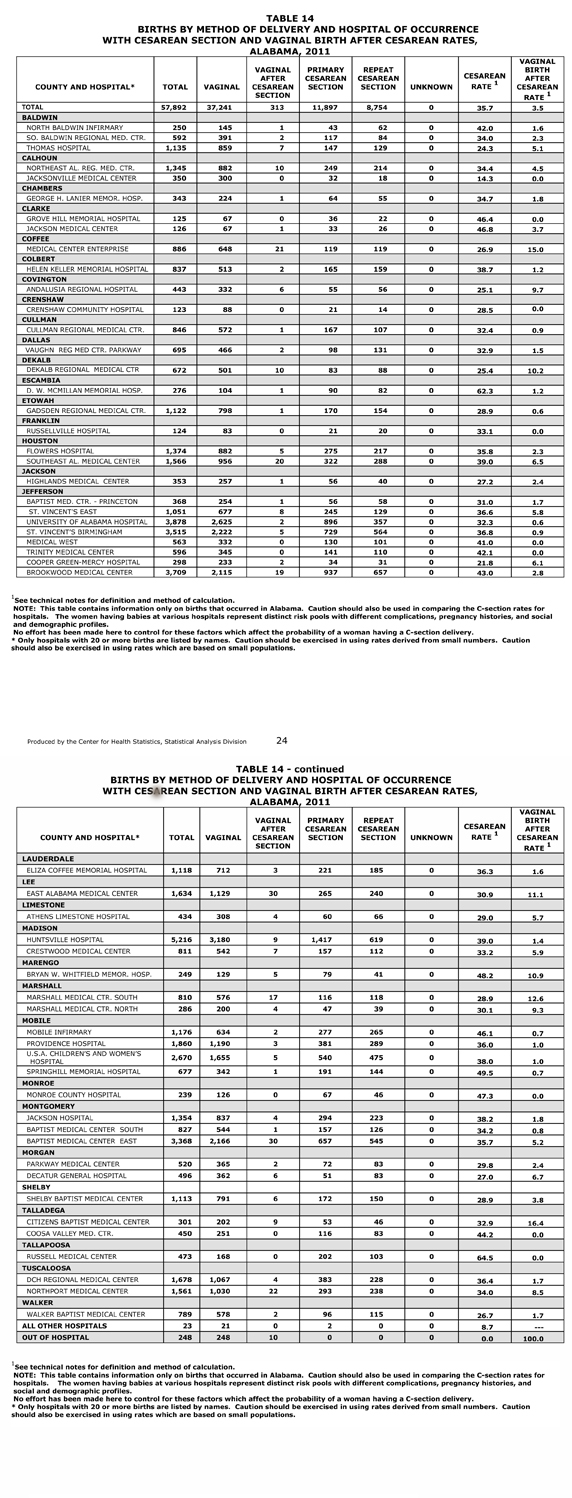Here are the statistics posted by the Alabama Department of Public Health
They list Vaginal, Cesarean, and VBAC rates for Alabama Hospitals.
The World Health Organization (WHO) recommends the c-section rate not exceed 10%-15%. (1) ACOG (American College of Obstetrics and Gynecologists) have reassessed their VBAC guidelines and stated “Attempting a vaginal birth after cesarean (VBAC) is a safe and appropriate choice for most women who have had a prior cesarean delivery, including for some women who have had two previous cesareans.” (2) These numbers NEED to change!!! We at ICAN of Huntsville are going to be working towards this change as hard as we can! I (Brianna) VBACed in Huntsville Hospital, which has 39.0% c-section rate and only a 1.4% VBAC rate. WOW. There are several Hospitals in outlying areas near Huntsville that have VBAC bans! Here is something you should know about VBAC bans… if your hospital doesn’t “allow VBAC’s” that DOES NOT mean you must have a repeat c-section. We as human beings can refuse a surgery at any time! You even have ACOG to back you up, they say “restrictive VBAC policies should not be used to force women to undergo a repeat cesarean delivery against their will. (3) This doesn’t just mean an all out VBAC ban, but also restrictive policies like you not starting labor by 40wks, or as long as the baby doesn’t look big, no twins, unknown type of uterine scar.
Do your research, educate yourself, you have options! And don’t let anyone feed you the line that it doesn’t matter as long as the baby gets here safely. It’s just not true. It does matter. That’s like someone telling you it doesn’t matter that you just got hit by a car while pushing your baby across the street in their stroller… it just matters that your baby is ok. While you are so very thankful and feel blessed to have your healthy baby in your arms getting hit by a car is not what you wanted, and it definitely has some very painful and negative consequences. You’d probably want to avoid doing that again if you could, wouldn’t you?

(1) World Health Organization. ,http://www.who.int/healthsystems/topics/financing/healthreport/29DeterminantsC-section.pdf
(2) American College of Obstetrics and Gynecology. ,http://www.acog.org/About%20ACOG/News%20Room/News%20Releases/2010/Ob%20Gyns%20Issue%20Less%20Restrictive%20VBAC%20Guidelines.aspx
(3) American College of Obstetricians and Gynecologists. Practice Bulletin No. 115: Vaginal Birth After Previous Cesarean Delivery. Obstetrics and Gynecology 2010, 116 (2), 450-463, http://journals.lww.com/greenjournal/Citation/2010/08000/Practice_Bulletin_No__115__Vaginal_Birth_After.40.aspx.
